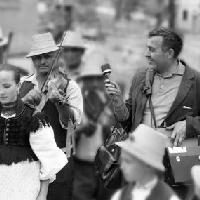Kallós Zoltán néprajzi gyűjteménye a népi kultúra megmentésének egyik legsikeresebb egyéni erőfeszítése. A szellemi és tárgyi értékmentést nemcsak a magyar kulturális örökség megőrzéséért, hanem az etnikailag sokszínű erdélyi Mezőségért és a moldvai csángók római katolikus lakosságának kollektív identitásáért is folytatta. A gyűjtő sikeresen szembeszállt a romániai kommunista rendszer azon politikai gyakorlatával, mely a társadalmi és kulturális homogenizációt kívánta elérni.
-
Hely:
-
Comuna Bonțida, Răscruci, Romania
-
Téma:
-
Alapítás ideje:
-
Ajánlott tétel:
Erős Ferenc interjú-gyűjteménye másodgenerációs holokaszttúlélőkkel készített mélyinterjúkat tartalmaz. Az első kezdeményezések egyike Magyarországon, amely a tabusított és elhallgatott holokauszt-emlékezet és a családon belüli feldolgozás, traumaikus átörökítés folyamatát igyekezett feltárni.
-
Hely:
-
Budapest Arany János utca 32, Hungary 1051
-
Téma:
-
Alapítás ideje:
-
Ajánlott tétel:
The Zagreb Gymnasium private collection consists of memorabilia from the 1985-89 period. The school was then named as the Educational Centre for Languages, and two of its classes, which retained the classical curriculum, were considered a peculiarity. It was highly exceptional at the time, because in the framework of the secondary school reform implemented by Stipe Šuvar in 1975-76, which promoted so-called “directed education,” all gymnasia in Croatia were transformed into some manner of vocational schools with the aim of preparing the students for the labour market. From the communist perspective, the classical education was deemed unnecessary petty bourgeois elitism, which prepared select students for the university and enhanced class inequality.
-
Hely:
-
Téma:
-
Alapítás ideje:
-
Ajánlott tétel:
This ad-hoc collection mainly consists of documents separated from the fond of judicial files concerning persons subject to political repression during the communist regime, currently held in the Archive of the Intelligence and Security Service of the Republic of Moldova (formerly the KGB Archive). It focuses on the case of Zaharia Doncev, a Moldavian worker who expressed his opposition to the Soviet regime in May 1955 by writing and distributing four “anti-Soviet” leaflets at the Chișinău railway station and in the surrounding area. Doncev’s case represents the first recorded instance of a nationally oriented oppositional message in the Moldavian Soviet Socialist Republic (MSSR) in the post-Stalinist period. This case should be linked to the early context of Khrushchev’s Thaw and to the impact of the partial liberalisation of the regime on certain Soviet citizens.
-
Hely:
-
Chișinău Bulevardul Ștefan cel Mare și Sfînt 166, Moldova 2004
-
Téma:
-
Alapítás ideje:
-
Ajánlott tétel:
Zbigniew Dłubak collection consists of photographs, sketches, and notes, and was one of the first collections to be digitalized, catalogued, and managed by the Archeology of Photography Foundation. The objective of the Foundation was twofold. Firstly, the Foundation aimed to present the heritage of one of the most prominent Polish visual artist working in the socialist time without oversimplifying and putting him into official – dissent culture dichotomy, but to show his place in the wider context of European visual arts. Secondly, the Foundation digitalized and presented various parts of Dłubak’s collection using newest methods of archival preservation and created a fully researchable content. Part of the photographs included in the Dłubak's collection was never shown before to a wider public and was kept in the Dłubak’s private archive.
-
Hely:
-
Warszawa Chłodna 20, Poland
-
Téma:
-
Alapítás ideje:
-
Ajánlott tétel:





